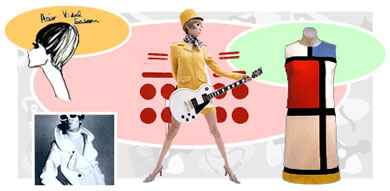Mods

Fashion Synopsis
“Don't try and dig what we all say
(Talking bout my generation),
Not trying to cause a big sensation
(Talking bout my generation),
Just talking bout my generation
(My generation),
This is my generation…”
The mod anthem, the Who’s “My Generation” characterized a group of working-class youths ostracized from conventional society but banded together by ‘clean living under difficult circumstances,” as described by the Who’s first manager, Pete Meadon.
Mod was not just a style, but a lifestyle. The term ‘mod’ carries much weight, representing two very different teen trends of the 60’s. Mod universally means ‘modern,’ which is often associated with the bright, day-glo colors of the swinging 60’s. But before there was mad, swinging mod, there was MOD.
The original mods, ‘modernists,’ were a gang of working-class British youths with strong interests in jazz, Italian scooters, button-down Fred Perry casuals and fine tailored clothing. These young kids, mostly boys, upheld a firm belief in refined minimalism.
Unemployment was low, and many teens earned their own money, most of which they spent on clothes and music. They wore Clark’s desert boots to protect their feet from the heat of the engine, and parkas kept them dry from the elements while cruising on their Vespa scooters. Their slim suits were worn, but impeccably tailored, and their hair was short and respectably styled.
They battled with the greasy rockers, unkempt in their jeans and leather jackets, ruffians to the mods’ understated chic. They disliked rock and roll, and instead listened either to jazz or to the newly formed 'mod' bands speaking their language, like the Who and Small Faces.
After an infamous riot with the rockers in ‘64, the true mod lifestyle faded, but it quickly evolved into the bold explosion of psychedelia, which would take over the mod realm and redefine it. And so there were the mods redux, the swinging 60’s psychedelic mods.
These mods took to the other extreme, flaunting bold colors and ostentatious patterns, making clothes from technologically advanced materials like vinyl, electrical lights and paper. They turned op-art into fashion and wore black and white geometric prints, or clothes colored in loud, day-glo psychedelics. They used pop art logos, wore mailing label dresses and Warhol’s soup can paper dresses. They strutted their stuff in miniskirts, go-go boots, and Beatles-inspired Sgt. Pepper uniforms or Nehru jackets.
Boys turned dandy, wearing frilly lace collars, velvet suits, and bold patterned ties. Paisley and polka dots were everywhere, worn with rainbow-striped mohair and iridescent two-tone suits. They wore pointed-toe Chelsea boots and cut their hair in feminine styles. Carnaby Street became the mod mecca, and designers John Stephen, Ossie Clark, Mary Quant and Biba changed the name of fashion.
The shops that lined Carnaby were filled with bright young things, prancing and preening from store to store. Their looks were more than modern, they were space-age. The parade of color, style and attitude infiltrated the conventional world. The mods separated themselves from the adults, and celebrated adolescence, but before long, even parents were wearing miniskirts and growing their hair out into mop tops. It was truly a mod, mod, mod, mod world.
